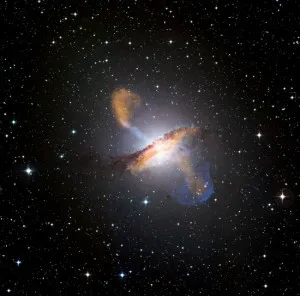A Guided Tour of the Universe
A new exhibition at the Natural History Museum gives visitors a dazzling view of our evolving universe
/https://tf-cmsv2-smithsonianmag-media.s3.amazonaws.com/filer/20111229090008Protostar-small.jpg)
A tour of the Natural History Museum might lead you from an exhibition on dinosaurs to one about ocean creatures. You might read about how hominids evolved millions of years ago, how our planet’s continents have moved, or how early creatures evolved when the atmosphere was practically devoid of oxygen. The time scale of natural history, you realize, is almost unimaginably large.
But if you enter the museum’s new exhibition, “The Evolving Universe“—a show featuring photography from some of the most powerful telescopes ever created—you’ll find yourself even more astounded. Set against the backdrop of the known universe, the history of our dear planet seems nearly irrelevant. Hundreds of billions of stars like our sun are born out of supernovae several light years wide (each light year is longer than five trillion miles) and are destined to die, once again exploding into supernovas, billions of years later. Thousands of galaxies, some containing trillions of stars like our sun, are continuously being born and evolving.
Although these concepts can be difficult to comprehend and even harder to visualize, the stunning photos that make up the exhibition show the visitor just how awe-inspiring these astronomical events can be. They put the latest CGI graphics from 3-D blockbuster films to shame. “Part of our mission is sharing science with the public, and so we felt that doing this exhibit and showing these images is a great way to do that,” says Jonathan McDowell, an astrophysicist at the Smithsonian Astrophysical Observatory, which partnered with the museum in creating the exhibition. The large-scale photographs in the show were produced by a number of telescopes, both Earth and space-based, including the Hubble Space Telescope.

“We’ve all seen the amazing pictures from NASA’s probes in our own solar system,” says McDowell. “I’m excited about bringing to the public the remarkable images of the broader universe that we astronomers have been exploring with our telescopes. I hope that with this exhibition visitors will take away an appreciation for our larger cosmic neighborhood.”
The show—and accompanying website—use these images to tell the story of our universe, from start to present. The Big Bang, the creation of galaxies, the birth of the Milky Way and the formation of our own solar system are represented in rich images so full of detail that they need to be observed for minutes at a time, like pieces of art hung on the wall.
What might be most remarkable is that the actual images created by the telescopes are themselves ancient history. Because light takes so long to travel from the far-flung reaches of space, when we photograph distant galaxies, the light that hits the camera’s lens to produce the image left its home galaxy billions of years ago. These pictures show some of the celestial objects as they were before humans even existed. And so we have a font-row seat to watch the earliest stages of the universe’s creation, if we look deep enough into space, more than 13 billion years later.
When wandering the exhibition, one might be overwhelmed by the torrent of information presented on scales that are downright otherworldly. How does our planet, so tiny and new, fit into all of this?
The best metaphor to understand earth’s place in the universe might be that of astrophysicist, author and recent Around the Mall blog subject Carl Sagan. In his book Pale Blue Dot, he describes a far-off view of the Earth from the outer reaches of the solar system:
From this distant vantage point, the Earth might not seem of any particular interest. But for us, it’s different. Look again at that dot. That’s here. That’s home. That’s us. On it everyone you love, everyone you know, everyone you ever heard of, every human being who ever was, lived out their lives. The aggregate of our joy and suffering, thousands of confident religions, ideologies, and economic doctrines, every hunter and forager, every hero and coward, every creator and destroyer of civilization, every king and peasant, every young couple in love, every mother and father, hopeful child, inventor and explorer, every teacher of morals, every corrupt politician, every “superstar,” every “supreme leader,” every saint and sinner in the history of our species lived there – on a mote of dust suspended in a sunbeam.
In the scheme of the known universe—of supernovae and galaxies and nebulas and black holes—our whole planet starts to look like a speck of dust, floating in the sunlight.
The Evolving Universe is on view at the Natural History Museum through July 7, 2013
/https://tf-cmsv2-smithsonianmag-media.s3.amazonaws.com/accounts/headshot/joseph-stromberg-240.jpg)
/https://tf-cmsv2-smithsonianmag-media.s3.amazonaws.com/accounts/headshot/joseph-stromberg-240.jpg)